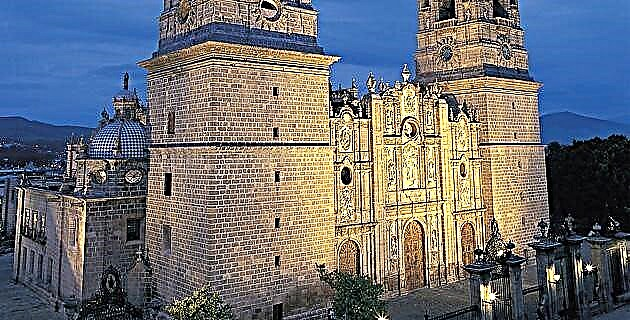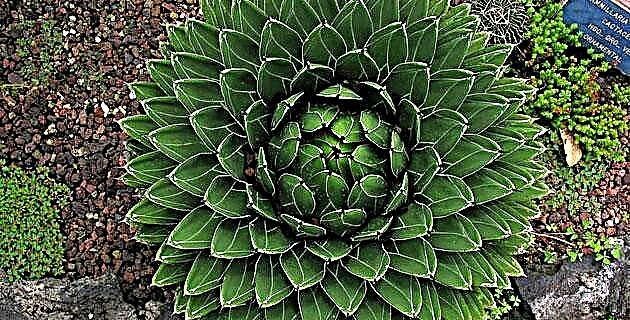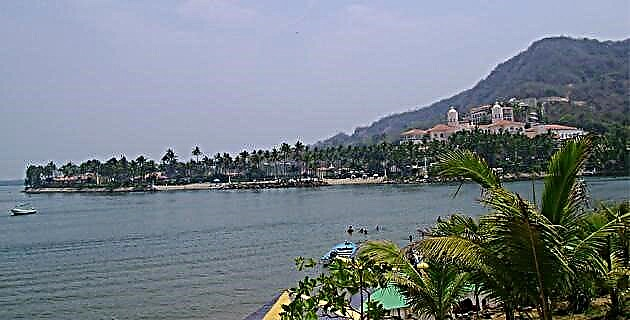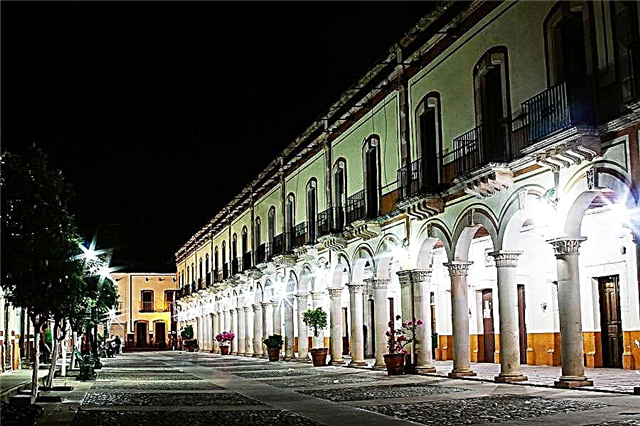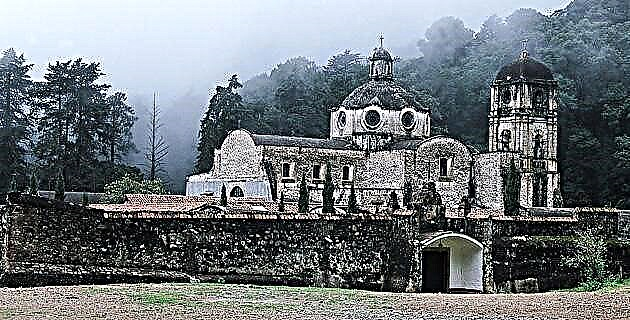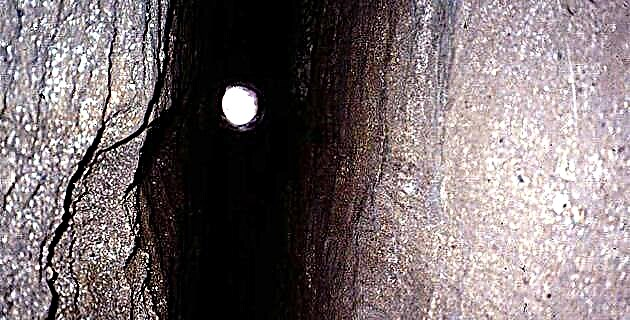
Speleology provides endless satisfactions, from those related to mental challenges, such as overcoming claustrophobia and fear of the great depths, to the joy that surrounds those moments when the topography of a cave is completed after endless hours of work between mud, guano, water and cold.
On the other hand, the feeling of reaching the end of one of those caverns that treasure hunters dared to go just a few meters inside is indescribable.
We recently discovered that unsuspected surprises can be found in caving. For example, what looked like a cave turned out to be something else entirely.
When, in 1985, we established our residence in Pinar de la Venta, Jalisco, we were alert to anything that indicated the presence of "caves." One day we observed something like this in the vicinity of La Venta del Astillero, and we decided to investigate.
The entrance was presented as a large arch-shaped mouth, 17 m high by 5 m wide, which led to a huge room illuminated with rays of light that penetrated through three perfectly round openings - 50 or 60 cm wide. diameter- located along the ceiling. Fascinating! We thought. This cavity was 70 m deep, 10 wide and 20 high and it seemed that its end was determined by a huge mound of earth from a landslide on the surface, which we verified when climbing. The large pit seemed to have been formed on purpose (apparently with explosives). We were also struck by the fact that, on the other side of the mound, the cavern seemed to continue in a narrow tunnel (3 or 4 m wide); As we did not have a downhill team, we had to leave that task for another time. Anyway, we took a tour in the direction of where the cavern seemed to continue. To increase our surprise, a few meters ahead we found a hole equal to those in the large cavity, and aided by our flashlights and the pebbles that we threw inside, we estimated a depth of 20 meters. Furthermore, we noticed a straight line that formed from the entrance to the cave and the collapse. We walked a little further and found another similar hole with a similar depth.
Days later, in the company of the geologist Henri de Saint Pierre, we had found a total of 75 mysterious holes, arranged in a straight line to the north, with a distance of 11 and 12 m between one and the other, of the first 29. The distance between the others varied. At 260 m the line became a "Y". A section turned west towards El Tepopote hill. The other one headed northeast, but due to undergrowth we couldn't investigate it. That afternoon we drew with Henri a map of the surface of the strange place.
What was it all about? If it had been formed for natural reasons, as Henri thought likely, how had it happened? If it was due to the hand of man, what could be the purpose of such a strange work? Either way, the only valid reality at the time was that we had found a cave with 75 entrances in an area of about one kilometer.
The probe that we went down through one of the holes showed the existence of water at the bottom, as well as human feces residues in the areas near a ranchería. From that moment on, the idea of continuing with the investigation was forgotten.
Another day, however, we made a descent at the site of the collapse. Obviously what we found on our way would determine the expedition.
By putting our feet on the ground and not perceiving any unpleasant odors, our attention was focused on the place itself. We were not wrong. It was a well-delineated tunnel-shaped cavity, sculpted in the compact volcanic ash that over the centuries had become enjal (from which the word “Jalisco” comes from). Sunlight fell through the round openings in the ceiling, like bright golden columns, and dimly illuminated the walls of the place and then reflected in the stream that, with difficulty, made its way between some twigs, stones and old garbage accumulated in some places. We started the walk towards the dark interior that 11 or 12 m later was lit up again. Some 150 m ahead, the ground succumbed to form a ditch that forced us to "chime" a long way. Then we find a cubic construction made of brick and pieces of an old pipe. The finding corroborated what we had heard from some people in La Venta: "It is said that for a long time the water that came from there supplied the town." Someone assured that, still in 1911, the water was collected for the use of the steam locomotives that stopped there. No one, however, provided us with information that would bring us closer to locating the origin of the cave. That day's exploration ended when we came across a considerable amount of rubbish that included more than one animal in a very advanced state of putrefaction.
ARCHAEOLOGISTS COME INTO ACTION
It was already the summer of 1993 when we met archaeologist Chris Beekman, who had come to do some work in the same forest area. Chris settled in Pinar de la Venta and since then we have followed him on some of his explorations, eager for information about the achievements of our ancestors.
On one occasion we invited him to our fabulous "cave of 75 entrances." As they crossed the threshold, the “great room”, Chris looked around in amazement. "MMM. This doesn't seem natural ”, he said as if talking to himself, and we, curious, followed him. "See those elongated indentations there?" He asked us, pointing up at the ceiling, to the side of one of the round holes. "They seem to be made with a pick or a similar tool," he continued, and doubts began to dance over our heads. Then, asking his opinion on the origin of the holes, he fixed his eyes on one of those openings through which, long ago, in wonder, we had watched the sun's rays descend.
"Well ... well ... Aha!", And he urged us to observe the dimples along the tunnels, possibly dug to pose feet and hands. "This is more than a cave," he commented with a look of triumph in his eyes.
In just a few moments we were convinced that the hand of man had intervened in that cave; that this cavern was… something else.
When Chris informed the experienced archaeologist Phil Weigando about the site, suspecting something special, he wasted no time.
"No doubt. This is unqanat, ”Weigand told us as soon as he entered the place. "And, in fact, it has a very special importance because of the information it will provide us about this type of systems and irrigation in America during the colonial era," he continued. Until that moment, he was the first qanat identified in western Mexico.
Unqanat (Arabic word) is an underground aqueduct through which water travels from one point to another. The tunnel is dug downwards below the water table and comes to an end in those places where water is required. The holes in the top provide ventilation as well as easy access to the tunnel for maintenance. Once the system starts to work, these holes are sealed by a rock, which we almost always find practically buried next to them. Finally the water was collected in the pool.
According to Weigand's research, for some historians the qanat come from Armenia (15th century BC); for others, from the deserts of ancient Persia, now Iran. The longest qanat in these regions is 27 kilometers. This ingenious technology, created to be applied in extreme adverse weather conditions, spread from the Middle East to Africa and was brought to Mexico by the Spanish, who learned it from the Moroccans. Among the qanat discovered in Mexico, some are found in the Tehuacán Valley, Tlaxcala, and Coahuila.
Chris Beekman estimated an extension of 3.3 km in this area, although, based on the versions of the locals, he considers that it may have reached about 8 km. The main conduit connected with three different water sources and led to an old ranch in La Venta, where it played a crucial role in agriculture during the dry season, when it is impossible to maintain favorable water levels if we take into account that the terrain it is porous by nature. From an economic point of view, as Weigand affirms, during the colonial period, excavation - from which 160,000 tons of earth emerged - was of above all practical importance.
The work in which we intervened cavers, geologists and archaeologists in elqanatde La Venta, could attract the interest of local historians to initiate a process focused on both the conservation and the protection of what is part of a historical legacy. The impact of such work would then mean giving other people the opportunity to walk through these passages and, in the middle of the day, marvel when the sun's rays descend through those round holes that form beautiful golden columns.
Source: Unknown Mexico No. 233 / July 1996

